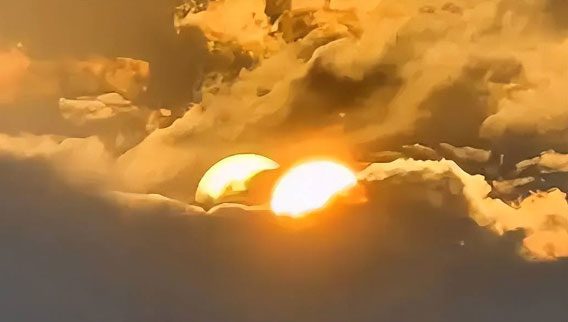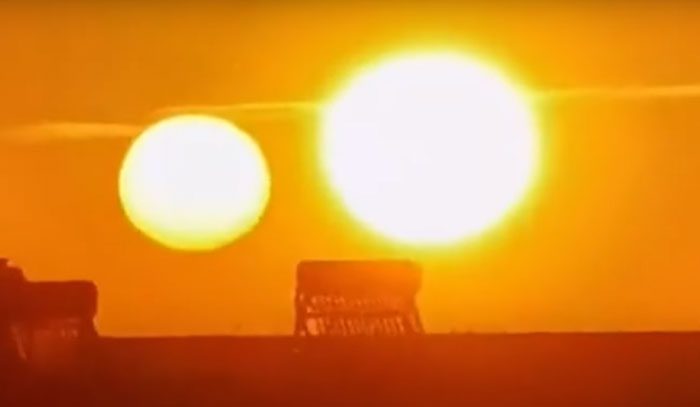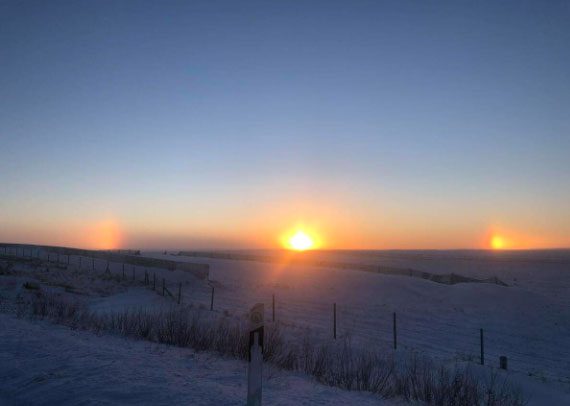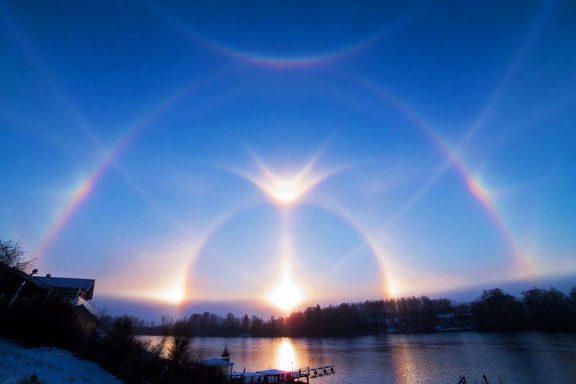We all know there is only one sun in the sky, yet the man below captured footage of two suns appearing together. What happened?
Multiple Suns Appearing in the Sky
According to the Guangzhou Daily, on July 7, 2023, a man named Xiao in Yuxin, Sichuan Province, China unexpectedly posted a video showing two suns appearing in the sky. The images in the video reveal one sun emitting bright light, while the second sun shines more faintly. This is indeed a rare sight.

Image of two suns appearing in the sky captured from Xiao’s video. (Image taken from the video).
Xiao stated that this was the first time he had seen two suns. He also posed a question to netizens, wondering if this could be some kind of cosmic phenomenon.
The video attracted significant attention from many people online. Netizens were also astonished by this phenomenon, with some humorously commenting that perhaps the recent unusual heat was due to the presence of two suns.

Photo of four suns appearing together in Shanxi, China. (Image: Sohu).
However, some opinions suggest that this phenomenon is not new. Previously, on February 28, 2023, a resident in Yuncheng, a prefecture-level city in Shanxi Province, China captured an image of four suns appearing in the sky. In the photo, the four suns are arranged in a horizontal line, with the outermost left sun being the brightest, while the others shine less brightly. So what causes the phenomenon of multiple suns in the sky?
A Rare Phenomenon
The occurrence of multiple suns appearing seems magical, but it can be explained through scientific principles. According to astronomers, this phenomenon is known as Parhelion. The name Parhelion is derived from the Greek words para-helios. This phenomenon has been documented in ancient records.

The phenomenon of multiple suns appearing in the sky is called Parhelion. (Image: Sohu).
According to the description on SkyBrary, Parhelion is one of the most unusual atmospheric phenomena. It is an atmospheric phenomenon caused by the sun but can also be considered an astronomical phenomenon. Parhelion typically occurs under specific environmental conditions and for a short duration, especially when clouds near the sun are relatively thick.
Parhelion involves two light rays forming on either side of the sun when interacting with a certain type of cloud. The clouds necessary for this phenomenon are called cirrus clouds. These clouds have a fibrous and cotton-like appearance and contain ice crystals that act like small prisms. These ice crystals refract sunlight from the sun, meaning they will bend part of the sunlight to create a sundog. This allows observers to see a sun behind the cloud, although it appears dimmer than the actual sun.

This phenomenon also occurs in icy regions with low temperatures. (Image: Sohu).
The Parhelion phenomenon does not occur at all times. Often, cirrus clouds may only appear on one side of the sun, forming only one sundog. Therefore, we cannot see the entire second sun.
Sometimes the Parhelion phenomenon appears as a circular bright spot. In this form, the second sun will be less bright. Typically, the Parhelion phenomenon occurs in the early morning or at sunset when the sun is below the horizon. Parhelion usually appears at an angle of 22 degrees from the sun, due to the refraction angle of the light rays.

The occurrence of multiple suns in the sky is very rare. (Image: Sohu).
Additionally, in snowy regions, the Parhelion phenomenon can also occur, such as in northern parts of the United States where temperatures drop to -20 degrees Celsius in winter. In these areas, the environmental conditions are perfect for ice crystals in cirrus clouds to form sundogs.
To witness the Parhelion phenomenon, two conditions must be met:
First, the cirrus clouds must be close to the sun.
Second, the cloud layer must be thin, with good light transmission, and furthermore, the angle between the sun, the ice crystals of the cirrus clouds, and the observer must be just right; even a slight deviation can make it impossible to see.


















































